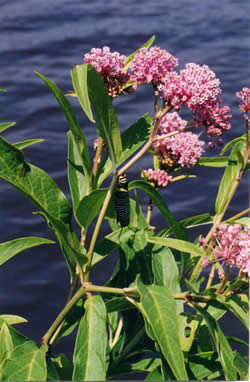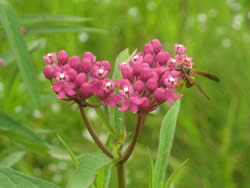Plant of the Week
 Range map of swamp milkweed. States are colored green where the species may be found.
Range map of swamp milkweed. States are colored green where the species may be found.
 Swamp milkweed with Monarch caterpillar. Photo courtesy of Jennifer Anderson, USDA-NRCS PLANTS Database.
Swamp milkweed with Monarch caterpillar. Photo courtesy of Jennifer Anderson, USDA-NRCS PLANTS Database.
 Swamp milkweed (Asclepias incarnata) with paper wasp. Photo courtesy of Linda R. Parker, U.S. Forest Service.
Swamp milkweed (Asclepias incarnata) with paper wasp. Photo courtesy of Linda R. Parker, U.S. Forest Service.
Swamp Milkweed (Asclepias incarnata L.)
By Forest Russell Holmes
Swamp milkweed, Asclepias incarnata, is named for the Greek god of medicine, Asklepios. Incarnata, is from the Latin carn, meaning flesh and atus, like, because its hue is sometimes like flesh or dusty rose in color.
As a tall herbaceous moisture-loving perennial, Swamp milkweed seeks sunny openings of swamps, marshes, bogs, fens, and open areas along stream banks and ditches. This robust and erect stemmed plant grows three to five feet high, and like its common milkweed cousin, exudes a milky juice when broken.
Swamp milkweed’s smooth narrow leaves are lance-shaped with sharp tips and occur in pairs. Sometimes the leaf’s edges turn inward and upward suggesting the prow of a ship.
The fragrant umbelled clusters of flowers range in color from soft mauve to pink to reddish-violet. Five tiny delicate petals are crowned with five nectar cups that are crucial in its intricate pollination. Within each small cup is an upward curving horn. An insect landing on the blossom slips on the horn. Its leg goes into a slit between the cups and picks up pollen. The same process is repeated as it visits other blossoms. Carrying its pollinia like large saddlebags, it then deposits them to fertilize other plants (sometimes insects are not strong enough to pull their feet out of the slits and they are trapped there and die). The fruit/seeds of the milkweed are attached to silky down and are encased in long one-chambered follicles, pods really, quite elegant in appearance. When the follicles dry, they split open, releasing the seeds with their downy parachutes to the wind.
Swamp milkweed attracts a profusion of butterflies, especially the monarch butterfly. Besides nectaring the monarch butterfly only lays it eggs on milkweeds. It will thrive in average garden soil as long as it does not dry out completely, especially in the spring. Thus, it is an excellent addition to a native plant garden.

